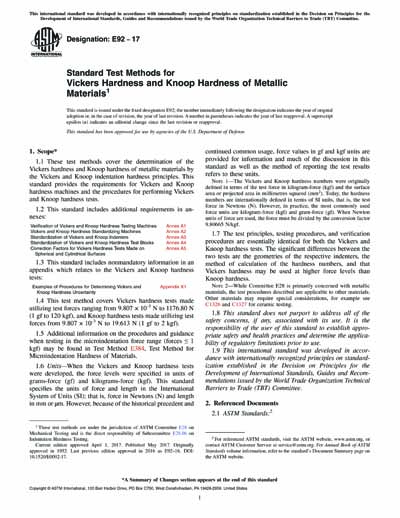Historical
ASTM E92-17
Standard Test Methods for Vickers Hardness and Knoop Hardness of Metallic Materials
1.1 These test methods cover the determination of the Vickers hardness and Knoop hardness of metallic materials by the Vickers and Knoop indentation hardness principles. This standard provides the requirements for Vickers and Knoop hardness machines and the procedures for performing Vickers and Knoop hardness tests.
1.2 This standard includes additional requirements in annexes:...
1.3 This standard includes nonmandatory information in an appendix which relates to the Vickers and Knoop hardness tests:
| Examples of Procedures for Determining Vickers and Knoop Hardness Uncertainty | Appendix X1 |
1.4 This test method covers Vickers hardness tests made utilizing test forces ranging from 9.807 × 10-3 N to 1176.80 N (1 gf to 120 kgf), and Knoop hardness tests made utilizing test forces from 9.807 × 10-3 N to 19.613 N (1 gf to 2 kgf).
1.5 Additional information on the procedures and guidance when testing in the microindentation force range (forces ≤ 1 kgf) may be found in Test Method E384, Test Method for Microindentation Hardness of Materials.
1.6 Units—When the Vickers and Knoop hardness tests were developed, the force levels were specified in units of grams-force (gf) and kilograms-force (kgf). This standard specifies the units of force and length in the International System of Units (SI); that is, force in Newtons (N) and length in mm or µm. However, because of the historical precedent and continued common usage, force values in gf and kgf units are provided for information and much of the discussion in this standard as well as the method of reporting the test results refers to these units.
1.7 The test principles, testing procedures, and verification procedures are essentially identical for both the Vickers and Knoop hardness tests. The significant differences between the two tests are the geometries of the respective indenters, the method of calculation of the hardness numbers, and that Vickers hardness may be used at higher force levels than Knoop hardness.
1.8 This standard does not purport to address all of the safety concerns, if any, associated with its use. It is the responsibility of the user of this standard to establish appropriate safety and health practices and determine the applicability of regulatory limitations prior to use.
1.9 This international standard was developed in accordance with internationally recognized principles on standardization established in the Decision on Principles for the Development of International Standards, Guides and Recommendations issued by the World Trade Organization Technical Barriers to Trade (TBT) Committee.
ASTM International [astm]

